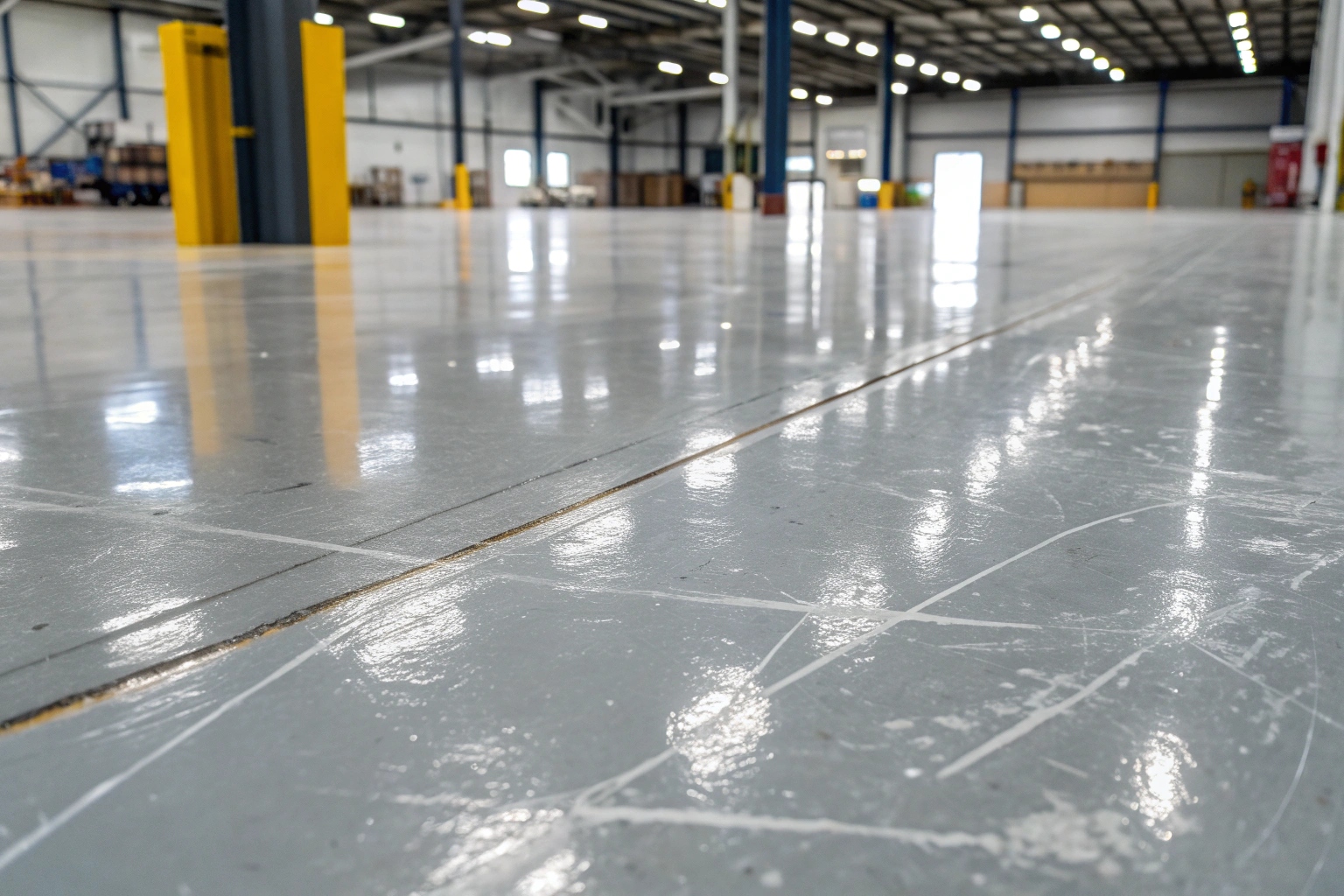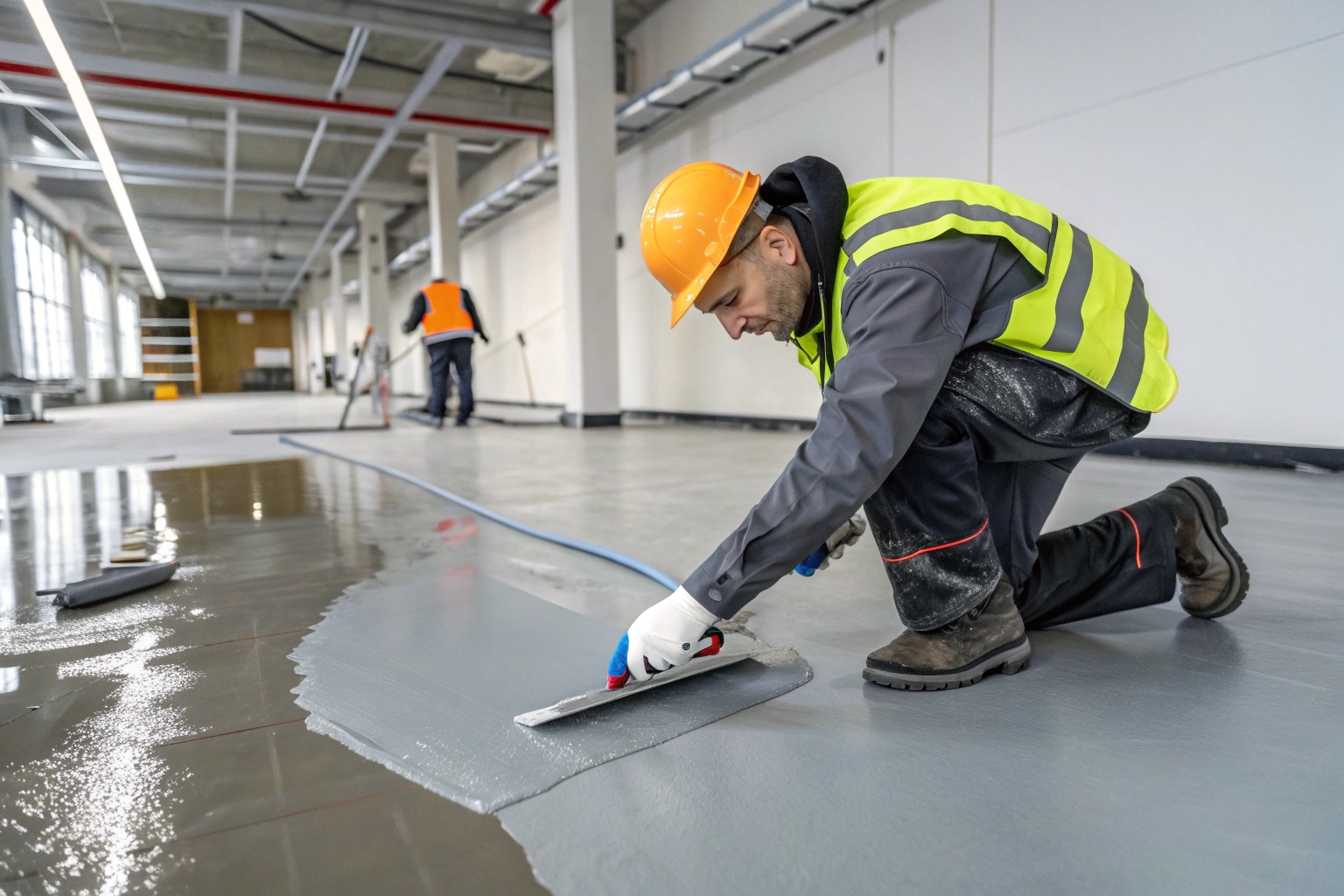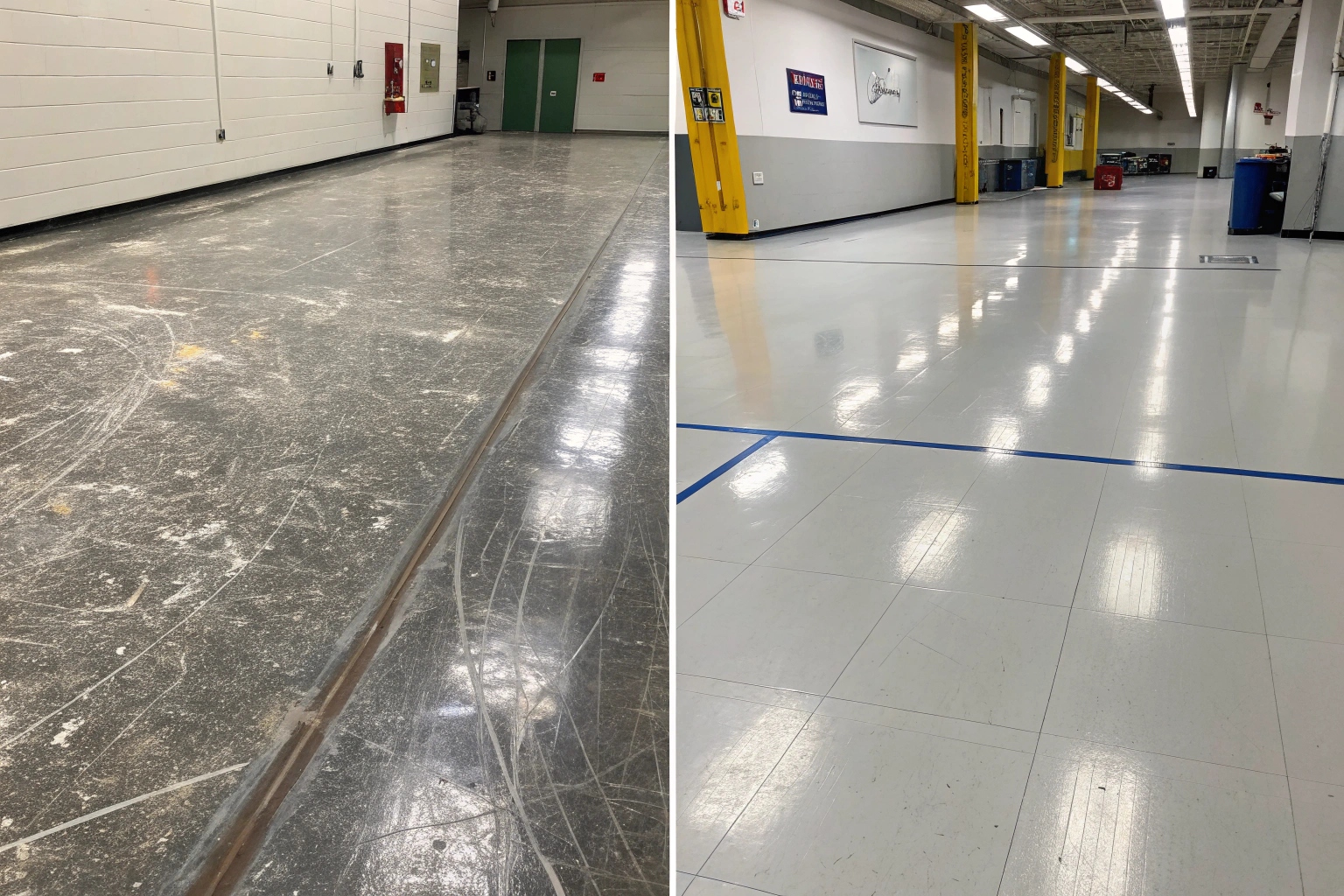Common Types of Floor Damage We Repair

Not all floor damage is created equal. Some scratches are just surface-level annoyances, while others go deep enough to compromise your floor’s protection. Here’s what we see most often in Wollongong facilities:
Surface Scratches and Scuffs
These are the light marks you get from dragging pallets or moving equipment around. They look bad, especially under bright lights, but they haven’t broken through your floor’s protective layer yet. Quick topcoat touch-ups usually handle these without any drama.
Deep Gouges and Chips
This is the heavy-hitter damage. Dropped tools, forklift impacts, or heavy machinery scraping across your floor. These cuts go deep enough to expose the concrete underneath. If you can see bare concrete, you need more than a touch-up. These require fill materials, proper colour matching, and structural repair to prevent the damage from spreading.
Impact Damage
We see this a lot in automotive workshops and manufacturing facilities. Something heavy hits the floor hard enough to create a crater or raised edges. These spots become trip hazards fast, and they collect dirt like nobody’s business. They need reinforcing materials along with the cosmetic repair.
Chemical Stains and Etching
Even chemical-resistant epoxy can get damaged if the wrong substance sits on it long enough. Oil stains, battery acid, or industrial chemicals can eat into your floor’s surface. These require contamination removal before we can restore the surface properly.
Wear Patterns
High-traffic areas wear down faster than the rest of your floor. You’ll notice dull patches where people walk constantly or where forklifts make their turns. These areas lose their shine and protective qualities, making them more vulnerable to further damage.

Our Repair Process and Colour Matching
The biggest question we get about floor repairs is whether anyone will be able to see where the fix was done. Fair question. We’ve all seen patchy repair jobs that look worse than the original damage.

Preventing Future Damage to Your Floors
Fixing damage is one thing. Stopping it from happening again is where the real value comes in. We’ve repaired enough floors around Wollongong to know which preventive measures actually work and which ones are just feel-good advice that doesn’t hold up in real-world conditions.
Simple Protection Strategies That Work
Start with proper cleaning methods. We’ve seen floors damaged by cleaning crews using the wrong equipment or harsh chemicals. Steel wool scrapers, abrasive pads, and acidic cleaners can scratch or etch your epoxy surface. Soft-bristle brooms and pH-neutral cleaners get the job done without creating damage.
Traffic management makes a bigger difference than most people realise. High-wear areas benefit from defined pathways and turn zones. If your forklifts always turn in the same spot, that area takes a beating. Varying traffic patterns when possible spreads the wear more evenly.
Equipment maintenance prevents a lot of impact damage. Forklifts with damaged wheels or rough edges cause more floor damage than well-maintained equipment. Same goes for pallet jacks with worn wheels. Regular equipment inspections catch these problems before they gouge your floor.
When to Call for Inspection
We recommend annual inspections for commercial and industrial floors. Catching small scratches early means quick repairs before they become major problems. For high-traffic facilities, twice-yearly inspections make more sense.
Watch for changes in how your floor looks under lighting. Dull spots or areas that don’t clean up as easily might indicate early wear that needs attention. Those worn areas lose their protective qualities first, making them vulnerable to chemical damage and moisture penetration.
Temperature swings and coastal conditions in Wollongong put extra stress on floors. Regular maintenance helps your floor handle these environmental factors without premature deterioration.

Industries We Serve in Wollongong
Different industries beat up their floors in different ways. What damages a retail floor won’t be the same as what tears up a manufacturing facility. We’ve worked across enough Wollongong businesses to understand exactly what each industry needs.
Industrial and Manufacturing
The Port Kembla industrial area keeps us busy. Heavy machinery, steel manufacturing, and processing plants create some of the toughest floor damage we see. Impact chips from dropped materials, chemical spills, and constant heavy equipment traffic all take their toll. These facilities need repairs that can handle the same punishment that caused the original damage. We use reinforced repair materials and enhanced topcoats for floors that keep taking a beating.
Warehouses and Logistics
Forklift damage dominates warehouse repair calls. Those steel wheels and tight turning radiuses create wear patterns and impact chips that spread fast if not addressed. Warehouse managers can’t afford extended downtime, so our repairs happen during off-shifts or around your operational schedule. Most warehouse repairs get completed overnight so you’re back to full operations by morning.
Automotive and Mechanical Workshops
Oil, brake fluid, transmission fluid – automotive shops expose floors to chemicals that can etch and stain epoxy surfaces. We see a lot of tool drop damage too. Service bay floors need repairs that restore both appearance and chemical resistance. These are customer-facing areas where floor condition affects your business image.
Commercial and Retail Spaces
Retail floors need to look perfect. Visible damage hurts your brand. High foot traffic creates wear patterns, and moving displays or fixtures can cause scratches. Our repairs for retail environments focus on seamless appearance – customers should never notice repair work.
Healthcare and Food Service
These environments have strict hygiene requirements. Damage to epoxy floors in kitchens or medical facilities can trap bacteria and contamination. Our repairs meet food-grade and healthcare standards, restoring the hygienic barrier your operations require.
FAQ - Chip and Scratch Epoxy Repair
Most spot repairs get completed in a few hours. Small chips and scratches can be fixed in 2-3 hours including cure time. Larger damaged areas might need 4-6 hours depending on the extent of damage and substrate condition. We schedule repairs around your operations whenever possible – a lot of our warehouse and industrial clients have us come in after hours so there’s zero disruption to their business day.
Yes, when done properly. We use custom colour-matching systems that replicate your exact floor shade. Your floor might have changed colour slightly from UV exposure or age, so we match the current colour, not what it looked like when first installed. We test our colour match before applying it to your floor to make sure it’s spot-on.
Most damage can be repaired successfully. However, if your floor has widespread damage, extensive substrate deterioration, or systemic adhesion failure, replacement might be more cost-effective than numerous repairs. We’ll give you an honest assessment – sometimes repair makes sense, sometimes it doesn’t. We’ve turned down repair jobs when we knew replacement was the better option for the client.
Spot repairs typically cost a fraction of full floor replacement. You’re looking at hundreds for repairs versus thousands for replacement. The exact cost depends on damage size, depth, and complexity. We provide upfront pricing after assessing your damage – no surprises or hidden charges.
For most repairs, we can get to you within a few days. Emergency repairs that pose safety hazards or risk further damage get priority response – sometimes same-day service. We keep common repair materials in stock so we’re not waiting on special orders to start your job.
Get Your Floor Repaired Before Small Damage Becomes a Big Problem
That chip in your floor isn’t going to fix itself. Every day you wait, moisture seeps deeper, the damage spreads wider, and your repair costs climb higher. We’ve seen it happen too many times across Wollongong facilities.
The good news is you’re already here, reading about solutions. You recognise there’s a problem. Now it’s just about taking the next step and getting it fixed before it gets worse.
We’ve been repairing epoxy floors throughout the Illawarra for years. Warehouses in Port Kembla, workshops in Figtree, retail spaces across the region – we’ve handled floor damage of every type and size. Our repair work comes with a warranty because we stand behind the quality of what we do.
Getting started is straightforward. Give us a call or send through some photos of your damaged floor. We’ll assess what needs to be done, give you honest pricing, and schedule the repair around your operations. Most repairs happen fast enough that you won’t even notice the disruption.
Don’t let floor damage become the problem that shuts down your operations or costs you thousands in emergency repairs. Small chips turn into major failures faster than you’d expect, especially in Wollongong’s coastal environment.
Call us today for a free assessment of your floor damage. Let’s get your floors back to looking and performing like new.
We’re local, we’re experienced, and we do the job right the first time. Your floor damage won’t fix itself – but we can fix it for you.

